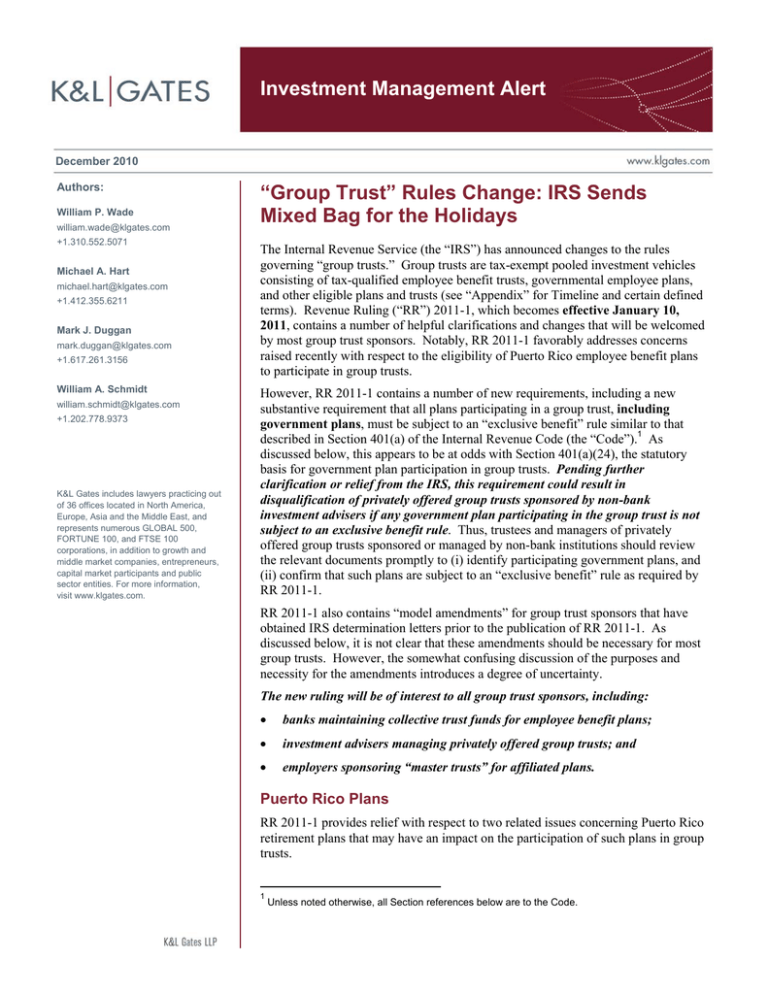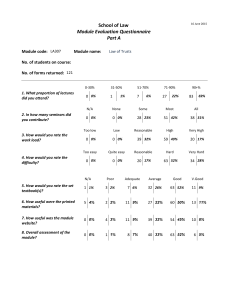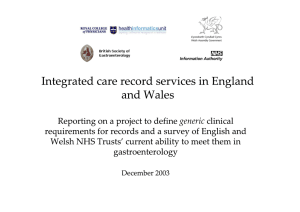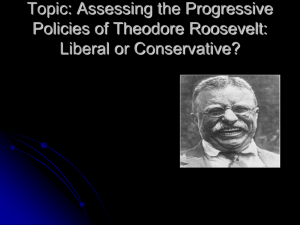
Investment Management Alert
December 2010
Authors:
William P. Wade
william.wade@klgates.com
+1.310.552.5071
Michael A. Hart
michael.hart@klgates.com
+1.412.355.6211
Mark J. Duggan
mark.duggan@klgates.com
+1.617.261.3156
William A. Schmidt
william.schmidt@klgates.com
+1.202.778.9373
K&L Gates includes lawyers practicing out
of 36 offices located in North America,
Europe, Asia and the Middle East, and
represents numerous GLOBAL 500,
FORTUNE 100, and FTSE 100
corporations, in addition to growth and
middle market companies, entrepreneurs,
capital market participants and public
sector entities. For more information,
visit www.klgates.com.
“Group Trust” Rules Change: IRS Sends
Mixed Bag for the Holidays
The Internal Revenue Service (the “IRS”) has announced changes to the rules
governing “group trusts.” Group trusts are tax-exempt pooled investment vehicles
consisting of tax-qualified employee benefit trusts, governmental employee plans,
and other eligible plans and trusts (see “Appendix” for Timeline and certain defined
terms). Revenue Ruling (“RR”) 2011-1, which becomes effective January 10,
2011, contains a number of helpful clarifications and changes that will be welcomed
by most group trust sponsors. Notably, RR 2011-1 favorably addresses concerns
raised recently with respect to the eligibility of Puerto Rico employee benefit plans
to participate in group trusts.
However, RR 2011-1 contains a number of new requirements, including a new
substantive requirement that all plans participating in a group trust, including
government plans, must be subject to an “exclusive benefit” rule similar to that
described in Section 401(a) of the Internal Revenue Code (the “Code”).1 As
discussed below, this appears to be at odds with Section 401(a)(24), the statutory
basis for government plan participation in group trusts. Pending further
clarification or relief from the IRS, this requirement could result in
disqualification of privately offered group trusts sponsored by non-bank
investment advisers if any government plan participating in the group trust is not
subject to an exclusive benefit rule. Thus, trustees and managers of privately
offered group trusts sponsored or managed by non-bank institutions should review
the relevant documents promptly to (i) identify participating government plans, and
(ii) confirm that such plans are subject to an “exclusive benefit” rule as required by
RR 2011-1.
RR 2011-1 also contains “model amendments” for group trust sponsors that have
obtained IRS determination letters prior to the publication of RR 2011-1. As
discussed below, it is not clear that these amendments should be necessary for most
group trusts. However, the somewhat confusing discussion of the purposes and
necessity for the amendments introduces a degree of uncertainty.
The new ruling will be of interest to all group trust sponsors, including:
•
banks maintaining collective trust funds for employee benefit plans;
•
investment advisers managing privately offered group trusts; and
•
employers sponsoring “master trusts” for affiliated plans.
Puerto Rico Plans
RR 2011-1 provides relief with respect to two related issues concerning Puerto Rico
retirement plans that may have an impact on the participation of such plans in group
trusts.
1
Unless noted otherwise, all Section references below are to the Code.
Investment Management Alert
1. Separation of Puerto Rico Plans and U.S.
Plans
The first issue involves “dual-qualified” retirement
plans that cover an employer’s U.S. participants
inside and outside Puerto Rico. Dual-qualified plans
are qualified under both Section 401(a) of the Code
and Section 1165(a) of the Puerto Rico Internal
Revenue Code (the “PR Code”). Because of
complications relating to the taxation of distributions
from dual-qualified plans, many of these plans are
being split into two separate plans, one covering
non-Puerto Rico participants (the “U.S. plan”); the
other covering Puerto Rico participants (the “Puerto
Rico plan”). The U.S. plan would be qualified only
under the Code, while the Puerto Rico plan would be
qualified only under the PR Code.
In RR 2008-40, the IRS concluded that this type of
separation would disqualify the existing plan under
the Code because it would be viewed as a transfer
from a U.S. qualified plan to a non-U.S. qualified
plan, which is impermissible under the Code.
However, recognizing the prevalence of dualqualified arrangements, the IRS, in RR 2008-40,
made that conclusion effective January 1, 2011 so
that dual-qualified plans could be separated without
adverse consequences under the Code through
December 31, 2010.
2. Puerto Rico Plan Participation in Group
Trusts
The second issue involves plans that are qualified
only under the PR Code. Under Section 1022(i)(1)
of the Employee Retirement Income Security Act of
1974 (“ERISA”), a plan that is qualified under the
PR Code (and not the Code) and that benefits only
Puerto Rico residents (a “Section 1022(i)(1) Plan”)
is treated as exempt under Section 401(a), which
means that investment income attributable to the
investment of assets of the Puerto Rico plan trust in
the U.S. is not taxable to the trust under the Code.
Many banks maintaining collective trust funds and
employers maintaining “master trusts” for affiliated
plans have permitted Section 1022(i)(1) Plans to
participate in their group trust arrangements. This
presumably is based on the view that Section
1022(i)(1) of ERISA treats Section 1022(i)(1) Plans
as if they are qualified plans under Section 401(a)
for all purposes. The IRS, moreover, has appeared
to approve the participation of Section 1022(i)(1)
Plans in group trust arrangements in Private Letter
Rulings.2
However, in a letter to Senator Arlen Specter dated
September 14, 2010, an IRS official stated that
Section 1022(i)(1) Plans cannot participate in group
trusts. This conclusion has raised doubts for group
trust sponsors that permit Section 1022(i)(1) Plans
to participate in their group trusts. In addition to
bank and non-bank sponsors that have allowed
Section 1022(i)(1) Plans to participate in their group
trusts, employers that have been in the process of
using RR 2008-40 to separate their dual-qualified
plans before January 1, 2011 were uncertain
whether they could permit the post-separation
Section 1022(i)(1) Plan to continue to participate in
their master trusts.
RR 2011-1, however, postpones the effective date
of RR 2008-40 until January 1, 2012. This should
give employers that desire to do so an additional
year to separate their dual-qualified plans. In
addition, RR 2011-1 announces the IRS’s intention
to issue guidance concerning the issue of whether a
Section 1022(i)(1) Plan may participate in a group
trust (whether pursuant to a separation of a dualqualified plan or otherwise). Until such guidance is
issued, RR 2011-1 states that a Section 1022(i)(1)
Plan may participate in a group trust so long as the
Plan either (i) was participating in the group trust as
of January 10, 2011, or (ii) holds assets that had
been held by a U.S.-qualified plan immediately
prior to the transfer of those assets to the Puerto
Rico plan pursuant to RR 2008-40.
Other Important Changes and Updates
A stated objective of RR 2011-1 is “[t]o ensure that
the assets of a group trust . . . are only commingled
with the assets of similar plans or arrangements”
(emphasis added). While the objective itself seems
logical, the premise of this statement is unclear to
the extent it suggests that the assets of a “group
trust,” as such (apparently consisting of qualified
plans and IRAs only), may somehow be
commingled with separate and distinct assets of
government plans and other types of plans.
Although the practical reality is that the assets of all
such plans are commingled in a group trust, RR
2
See, e.g., IRS Private Letter Rulings 200336034, 9621031,
and 9243053.
December 2010
2
Investment Management Alert
2011-1 seems to assume, but not explain or identify,
the existence of a separate investment vehicle in
which the assets of a group trust, on the one hand,
and such other plans, on the other hand, may be
commingled. Regardless of whether any such
separate “vehicle” actually is intended, at least some
of RR 2011-1’s changes seem to be based on this or
a similar rationale.
Highlights of these and other changes are detailed in
this alert.
1. Adoption Requirement
RR 81-100 requires that the group trust itself be
adopted as a part of each participating plan and IRA.
RR 2011-1 retains this requirement for all types of
eligible plans (see “Participation Requirement”
below). Both RR 2011-1, which addresses
government plans generally, and RR 2004-67, which
dealt specifically with 457 Plans, thus appear to
extend the “Adoption Requirement” to government
plans, although no such requirement appears in
Section 401(a)(24).
2. Participation Requirement
RR 81-100 limits group trust participation to
qualified plans and IRAs, and Section 401(a)(24)
extends group trust participation to government
plans within the scope of that Section. RR 2011-1
modifies and expands the “Participation
Requirement” as follows:
Government Plans. While the “holding” of RR
2004-67 specifically addressed 457 Plans only, the
“holding” of RR 2011-1 now refers to both 457
Plans and government plans described in Section
401(a)(24). Since 457 Plans are a subset of eligible
government plans described in Section 401(a)(24),
this aspect of RR 2011-1 introduces ambiguity. The
IRS also concluded that government plans providing
retiree welfare benefits are within the scope of
Section 401(a)(24) and, therefore, are eligible to
participate in a group trust. Banks sponsoring
collective trust funds structured as group trusts will
want to confirm that government welfare plans
satisfy the requirements of applicable securities law
exemptions.
Section 403(b) Plans. RR 2011-1 provides that
“custodial accounts” described in Section 403(b)(7)
and “retirement income accounts” described in
Section 403(b)(9) may participate in a group trust.3
(On the other hand, the IRS requested comments on
whether “annuity contracts and/or other tax-favored
accounts held by plans described in § 401(a) or
§ 403(b), such as pooled separate accounts
supporting annuity contracts that are treated as
trusts under § 401(f), should be permitted to invest
in the group trusts.”) The IRS also stated that a
403(b)(7) custodial account, which by law must be
invested exclusively in shares of registered
investment companies, may be “commingled in a
group trust that solely contains the assets of other §
403(b)(7) custodial accounts.” The IRS did not
indicate whether a 403(b)(7) custodial account
could participate in a group trust open to any
eligible participants, so long as the group trust is
invested entirely in mutual fund shares. The
expansion of group trust eligibility to 403(b) Plans
will not be useful to bank-sponsored group trusts to
the extent such trusts are operated in reliance on
securities law exemptions currently applicable to
collective trust funds maintained by banks.
PBGC Commingled Trusts. RR 2011-1 provides
that a group trust may hold assets attributable to
commingled trust funds maintained by the Pension
Benefit Guaranty Corporation for the assets of
terminated qualified plans. This codifies a position
taken by the IRS’s general counsel in 1986.4
3. Exclusive Benefit Requirement
RR 81-100 requires that the group trust instrument
prohibit the use or diversion of group trust assets for
any purposes other than for the “exclusive benefit”
of participants under the participating trusts. RR
2011-1 retains this requirement. However, RR
2011-1 also requires that the governing document of
each participating plan also include an irrevocable
“exclusive benefit” restriction. Qualified plans,
IRAs, and 403(b) Plans, as well as government
plans qualified or described under Sections 401(a)
and 457(b), are subject to “exclusive benefit”
requirements or similar restrictions under their
governing statutes. Other government plans
described in Section 401(a)(24), however, are not
necessarily subject to an “exclusive benefit” rule.
3
The IRS had indicated previously that a governmentsponsored 403(b) Plan could participate in a group trust.
See IRS Private Letter Ruling 200303041.
4
IRS General Counsel Memorandum 39712 (June 17, 1986).
December 2010
3
Investment Management Alert
Consequently, the expanded “Exclusive Benefit
Requirement” is at odds with Code Section
401(a)(24), which reflects Congress’ intention that
group trusts not be affected adversely merely
because they accept moneys from “a retirement plan
of a State or local government, whether or not the
plan is a qualified plan and whether or not the
assets are held in trust, or . . . any State or local
government monies intended for use in satisfying an
obligation . . . to provide a retirement benefit. . . .”5
Bank-sponsored group trusts that rely on securities
law exemptions applicable to “collective trust funds
maintained by banks” already are required to limit
government plan participants to those that are
subject to an exclusive benefit rule described in
Section 3(a)(2) of the Securities Act of 1933.
However, that requirement does not extend to
privately offered group trusts sponsored by nonbank advisers. RR 2011-1 does not provide
guidance with respect to what actions, if any, are
required of the latter category of group trusts that
currently includes government plans that are not
subject to an exclusive benefit rule, but a reasonable
reading of RR 2011-1 indicates that such plans
would need to be removed from the group trust by
January 10, 2011 in order to avoid disqualification.
4. Trust Requirement
RR 2011-1 adds a new requirement that each
participating plan must itself be a trust, a custodial
account, or “similar entity” that is tax-exempt under
Section 408(e) or Section 501 (or is treated as being
tax-exempt under Section 501). IRAs are exempt
under Section 408(e), and qualified plans, 403(b)
Plans, and 457 Plans are, or are treated as being,
exempt under Section 501. All of such plans by law
are or are funded by “trusts” or accounts that are
treated as trusts under Section 401(f). RR 2011-1
further provides that government plans described in
Section 401(a)(24) (other than 457 Plans) are treated
as meeting this requirement if the plans are not
subject to federal income taxation. This requirement
should not result in changes being necessary for
most group trusts.
5. “Separate Account” Requirement
“To ensure that the assets of a group trust . . . are
5
H.R. Conf. Rep. No. 760, 97th Cong., 2nd Sess. 640 (1982)
(emphasis added).
only commingled with the assets of similar plans or
arrangements,” RR 2011-1 adds a new requirement
that the group trust must keep separate records of
each participating plan’s interest. To satisfy this
requirement, the group trust instrument must
“expressly provide” for “separate accounts” and
“appropriate records” to be maintained to reflect the
interest of each participating plan in contributions to
and disbursements from the group trust, as well as
“investment experience of the group trust “allocable
to that account.” (See further discussion under
“Model Amendments” below.)
6. Anti-Assignment Requirement
RR 2011-1 retains essentially unchanged the
requirement in RR 81-100 that the group trust
instrument prohibit participating plans from
assigning their interests in the group trust.
7. Domestic Trust Requirement
RR 2011-1 retains essentially unchanged the
requirement in RR 81-100 that the group trust be
created in the U.S. and at all times be maintained as
a domestic trust in the U.S.
Model Amendments
RR 2011-1 includes two “model amendments” for a
group trust that received a determination letter
before January 10, 2011: one dealing with the new
Separate Account Requirement; the other dealing
with the expanded Participation Requirement.
The IRS indicates that, if the group trust instrument
provides that amendments to the instrument
“automatically pass-through” to each participating
plan, the group trust sponsor will not lose its right to
rely on the determination letter merely because it
adopts the model amendments (or substantially
similar amendments), or because it modifies or
deletes a pre-existing group trust provision that is
“inconsistent with” the model amendment. On the
other hand, the IRS states if the group trust “does
not contain such a pass-through provision,” the
sponsor may not adopt the model amendment and
automatically continue to rely on its prior
determination letter. Although RR 2011-1 is silent
on the subject, group trusts in the latter category that
need to adopt amendments presumably must add
“pass through” language and seek new
determination letters.
December 2010
4
Investment Management Alert
The references to the “pass-through” of group trust
amendments are ambiguous. A group trust typically
contemplates that participating plans, by virtue of
their continued participation in the group trust, are
subject to group trust amendments. Whether this
means that amendments to such a group trust
effectively “pass through” to participating plans for
purposes of RR 2011-1 is unclear. Moreover, as
discussed below, it is not at all clear in most cases
whether such amendments should be necessary in
the first place.
1. Separate Account Requirement Amendment
Model “Amendment 1” (consisting of a single
sentence) is intended for a group trust that does not
satisfy the “Separate Account Requirement.” In
such case, the amendment must be adopted by
January 10, 2012.
In our experience, most group trusts provide,
specifically or in substance and effect, for “separate
accounts” as described in RR 2011-1. RR 2011-1
nonetheless introduces uncertainty as to whether the
language of existing group trust instruments
“expressly provides” for separate accounts in the
particular manner contemplated by RR 2011-1. It
also is unclear whether the IRS intended to require
industrywide amendments to deal with an issue that
ordinarily is considered fundamental to the structure
of a group trust or other pooled investment vehicle.
2. Participation Requirement Amendment
Model “Amendment 2” (consisting of two
paragraphs) is for a group trust that “intends to
permit” 403(b) Plans or government plans under
Section 401(a)(24) to participate in the group trust.
Given that 403(b) Plans will be permitted to
participate in a group trust for the first time, it is
likely that group trust sponsors wishing to take
advantage of this expansion of eligibility would
adopt such an amendment in any event. On the
other hand, it is unclear why the IRS would suggest
an amendment for a group trust that “intends” to
allow participation by government plans described
in Section 401(a)(24), when such plans have been
eligible to participate in group trusts for nearly three
decades.
Presumably, group trust sponsors that have
“intended” to allow participation by such plans
already would have amended their group trust
instruments to so provide. Although RR 2011-1
might raise potential questions for group trusts that
do not include specific references to Section
401(a)(24) in the manner provided by the model
amendment, other language that is “substantially
similar” to the model amendment should be
sufficient.
Unlike the model amendment for “separate
accounts” described above, RR 2011-1 does not
specify a date by which this model amendment
should be adopted. This suggests, perhaps, the
IRS’s view that the amendment is appropriate or
necessary only for those group trusts that intend to
allow government plan participation on a
prospective basis.
Appendix
Group Trust Timeline:
1956. RR 56-267 holds that, if certain requirements
are satisfied, the status of employee benefit trusts
“qualified” under Section 401(a) and exempt from
taxation under Section 501 (herein, “qualified
plans”) will not be affected adversely by the pooling
of their funds in a group trust, and the group trust
itself will constitute a qualified trust under Section
401(a) and be exempt from tax under Section 501.
1981. RR 81-100 consolidates earlier rulings to
permit individual retirement accounts (“IRAs”)
exempt from tax under Section 408(e) to participate
in a group trust. RR 81-100 retains and applies the
requirements of RR 56-267 to qualified plans and
IRAs participating in group trusts.
1982. Congress enacts Section 401(a)(24), which
provides that a group trust that otherwise meets the
requirements of Section 401(a) will not fail to
satisfy such requirements “on account of
participation or inclusion in such trust of the
moneys of any plan or governmental unit described
in section 818(a)(6).” Section 818(a)(6), in turn,
refers to governmental plans within the meaning of
Sections 414(d) and 457(b).
2004. RR 2004-67 “extends the holding” of RR 81100 to government plans described in Section
457(b) (“457 Plans”) and clarifies that Roth IRAs
described in Section 408A and “deemed IRAs”
described in Section 408(q) may participate in
group trusts. (Since Section 401(a)(24), enacted 22
years earlier, already permitted group trust
participation by governmental plans, including 457
December 2010
5
Investment Management Alert
Plans, many industry participants viewed RR 200467 to be unnecessary to the extent it purported to
“extend” such participation to 457 Plans.)
2011. RR 2011-1 modifies the rules governing
group trusts effective January 10, 2011. Among
other positive changes, RR 2011-1 extends
eligibility for group trust participation to certain
plans described in Section 403(b) (“403(b) Plans”).
However, RR 2011-1 also establishes a new
“separate account” requirement and contains
problematic references and requirements relating to
government plans described in Section 401(a)(24).
Anchorage Austin Beijing Berlin Boston Charlotte Chicago Dallas Dubai Fort Worth Frankfurt Harrisburg Hong Kong London
Los Angeles Miami Moscow Newark New York Orange County Palo Alto Paris Pittsburgh Portland Raleigh Research Triangle Park
San Diego San Francisco Seattle Shanghai Singapore Spokane/Coeur d’Alene Taipei Tokyo Warsaw
Washington, D.C.
K&L Gates includes lawyers practicing out of 36 offices located in North America, Europe, Asia and the Middle East, and represents numerous
GLOBAL 500, FORTUNE 100, and FTSE 100 corporations, in addition to growth and middle market companies, entrepreneurs, capital market
participants and public sector entities. For more information, visit www.klgates.com.
K&L Gates comprises multiple affiliated entities: a limited liability partnership with the full name K&L Gates LLP qualified in Delaware and
maintaining offices throughout the United States, in Berlin and Frankfurt, Germany, in Beijing (K&L Gates LLP Beijing Representative Office), in
Dubai, U.A.E., in Shanghai (K&L Gates LLP Shanghai Representative Office), in Tokyo, and in Singapore; a limited liability partnership (also named
K&L Gates LLP) incorporated in England and maintaining offices in London and Paris; a Taiwan general partnership (K&L Gates) maintaining an
office in Taipei; a Hong Kong general partnership (K&L Gates, Solicitors) maintaining an office in Hong Kong; a Polish limited partnership (K&L
Gates Jamka sp.k.) maintaining an office in Warsaw; and a Delaware limited liability company (K&L Gates Holdings, LLC) maintaining an office in
Moscow. K&L Gates maintains appropriate registrations in the jurisdictions in which its offices are located. A list of the partners or members in each
entity is available for inspection at any K&L Gates office.
This publication is for informational purposes and does not contain or convey legal advice. The information herein should not be used or relied upon
in regard to any particular facts or circumstances without first consulting a lawyer.
©2010 K&L Gates LLP. All Rights Reserved.
December 2010
6







